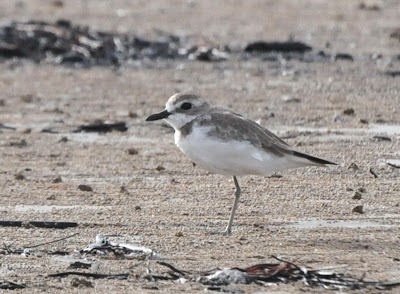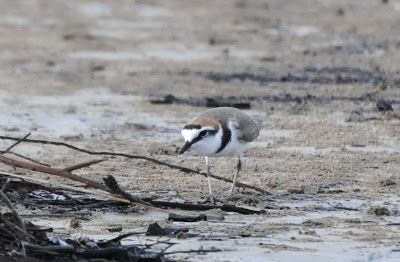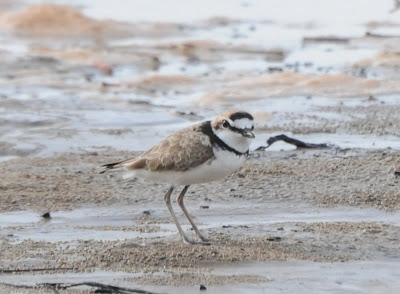The Malaysian Plover breeds from Vietnam to the Lesser Sundas. Its overall numbers appear to be low (perhaps less than 25,000 birds), and Birdlife International classifies it as Near-Threatened.
On February 27, 2012, my friend Anthony Wong (a shorebird, or wader, devotee) invited me on a trip to the beach - particularly to see the Malaysian Plover, practically a new bird for me (I had only had my first, distant view of one a few weeks earlier, at Sedili Besar in West Malaysia during our MNS excursion to Panti Forest). Anthony's truck made for an excellent photographic blind.
Along for the ride was my grandson Ryan, who not only behaved very well (for being cooped up in the truck with a couple of birders) but even pointed out some birds for us. Of course, digging in the sand with a stick, which he got to do later, was more fun than birding.
The commonest birds on the beach were sandplovers. This late in the season the Lesser Sandplovers (Charadrius mongolus) had largely departed for the north, and all the birds in these photographs, including this one, are Greater Sandplovers (C. leschenaultii).
Many thanks, by the way, to Dave Bakewell, who kindly turned his expert eye to the shorebird identifications in this post before I released it on my unsuspecting readers!
In addition to shape and bill size, breeding-plumage Greaters have a much more restricted chestnut breast band than their smaller cousins.
The breeding-plumage adults are handsome birds indeed.
Here are some more winter-plumage birds. Anthony and I thought they were all Greaters, and Dave, I am glad to say, concurs.
This bird is different (and thanks to Dave for confirming the ID): a Kentish Plover (Charadrius alexandrinus nihonensis). Notice, among other things, the finer bill and the white collar on the hind neck. Nihonensis, which (as its name implies) breeds mostly in Japan, is the wintering form to be expected in East Malaysia.
According to Dave, the chief features that distinguish nihonensis from nominate Kentish Plovers (that is, Charadrius alexandrinus alexandrinus) are:
- pale legs
- long breast patches, often forming a complete breast band
- a greater tendency to show foxy chestnut colouration in females and first year birds
These birds are nihonensis Kentish Plovers in breeding plumage (birds I first misidentified as Malaysian Plovers, so ignore the file names, please!).
Note the nearly complete breast band on this bird.
This, I believe, is a female in breeding plumage. Again, ignore the file name. Notice the "foxy" reddish, not white, of the superciliary line behind the eye.
These birds, too, are nihonensis Kentish Plovers, with very extensive breast patches.
According to Dave, the chief features that distinguish nihonensis Kentish Plovers from Malaysian Plovers in any plumage are:
- larger size
- longer, slenderer-looking, sharper bill
- 'centre of gravity' more central (MPs look as if they're about to tip forward, as they have more 'chest' in front of the legs)
- shorter legs (proportionally if not actually)
- less 'motley' upperparts (less contrast between feather centres and edges)
Finally, genuine Malaysian Plovers!
Notice the shorter superciliary line as compared to the Kentish Plovers, and, particularly, the black collar extending across the mantle, a distinctive feature of breeding male Malaysians. Notice, too, a key field mark in any plumage: the light edging to the mantle feathers and scapulars, giving the bird a distinctive "scaly" appearance (what Dave, in his comments, calls "motley").
This field mark shows up clearly here - compare with the "smooth-backed" Kentish Plovers, above. The breast band is not quite complete in this bird - unlike the male in the next photograph.
These, too, are Malaysians; the upper bird is an adult male, the lower probably a female.
It's almost a relief to move to our last species, a shorebird that it is difficult to mistake for any other: the Terek Sandpiper (Xenus cinereus). The name refers to the Terek River in Russia.
Anthony and I almost missed this bird while we were busy with the plovers - Ryan was the one who pointed it out!
Its neat grey plumage, rather short orange legs and long, slightly upturned bill combine to make it one of the most distinctive of sandpipers. There is really nothing else quite like it.
Mind you, at times the bill can be hard to see.
Before we left the beach, I took a last look offshore at the Satang Islands, themselves the subjects of an account I posted here just over a year ago….
and we ended the day by giving Ryan a chance to explore the beach (his way).



































No comments:
Post a Comment